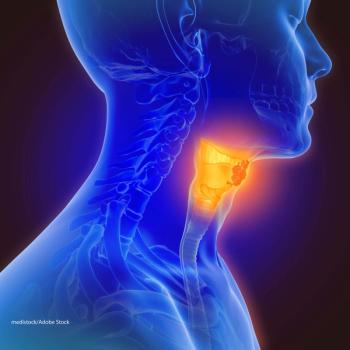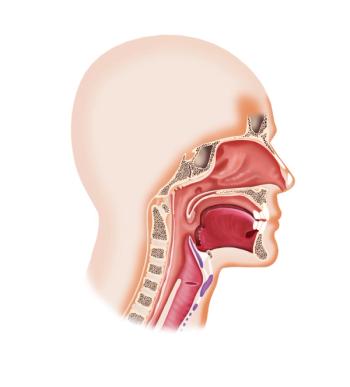
- ONCOLOGY Vol 14 No 10
- Volume 14
- Issue 10
Commentary (Stenson): Indications for Selective Neck Dissection: When, How, and Why
Selective neck dissection is a procedure that is primarily indicated in patients with clinically negative nodal disease in which there is a high risk of occult metastases. Others have advocated its use for patients with
Dr. Robbins is widely respected and known for his competent leadership in the field of head and neck oncologic surgery, as well as the entire specialty of otolaryngology/head and neck surgery. I consider the opportunity to write a commentary on Dr. Robbins’ work a wonderful privilege.
The neck dissection has evolved from radical removal of cervical lymphatics to a structure- and function-preserving procedure. In the past, the terminology for these “conservation” neck dissections has been inconsistent. Dr. Robbins has been instrumental in standardizing the terminology of neck dissections.[1] The following paragraphs will serve as an adjunct to Dr. Robbins’ article and highlight areas of continued controversy on the topic of selective neck dissection.
One of the more fascinating aspects of the selective neck dissection is its historical anatomic basis. Dissection of cervical anatomy by Suarez in 1963 offered significant conclusions: The fibrofatty lymph node–bearing tissue of the neck is completely separate from, and has no direct anastomosis to, the fascia that surrounds the muscles, vessels, and glands within the neck.[2,3] Therefore, an oncologically sound lymphadenectomy can be performed without sacrificing critical structures. Bocca et al popularized this “functional” neck dissection in the 1970s and 1980s.[4] In the 1990s, it became widely accepted as the superior alternative to the radical neck dissection for N0 and N1 neck disease.
Debate Over Indications
Continued controversy surrounds the indications for selective neck dissection. Some authorities caution against using selective neck dissection for multiple clinically positive nodes. The quoted 30% and 33% failure rate in Dr. Robbins’ article is somewhat misleading, however.[5] These figures refer to the regional recurrence rate in 39 patients with multiple positive nodes who underwent an anterior/lateral neck dissection: 9 (30%) of 30 patients treated with postoperative radiotherapy had a recurrence, compared with 3 (33.3%) of 9 patients who did not receive postoperative radiotherapy. In fact, in their 1999 study, Byers et al reported a 22.1% incidence (112 of 517 selective neck dissection specimens) of multiple positive nodes.[5] The regional failure rate in the 92 patients with multiple positive nodes who received postoperative radiotherapy was 17.4% (16 of 92 patients). The regional failure rate of the 20 patients with multiple positive nodes who did not have postoperative radiotherapy was 15%. The overall regional recurrence rate was 6.1% (n = 14) of 231 patients who underwent neck dissections without postoperative radiotherapy, and 8.0% (n = 23) of 286 patients with postoperative radiotherapy.
Bocca described no regional recurrences in 100 patients who underwent selective neck dissection (what he describes as conservation or functional neck dissection), and recommends selective neck dissection for all mobile nodes, with the only absolute contraindication being nodal fixation.[4] It is worth pointing out that Bocca removed levels I through V in his neck dissections, and actually performed what is now known as a type III modified radical neck dissection.
Significance of Nodal Yields
Nodal yield of neck specimens may improve our understanding of the indications and ramifications of the various neck dissections. Bhattacharyya studied the effect of neck dissection on the nodal yields in patients who underwent radical neck dissection (42), modified radical neck dissection (57), or selective neck dissection (34).[6] Although the total nodal yield was significantly different among the various neck dissections, the positive (pathologic) nodal yield was not (P = .62). Clearly, future prospective studies are warranted to evaluate the efficacy of selective neck dissection for patients with multiple positive nodes.
Controversy over the management of the node-negative neck will not be entirely resolved until prospective studies are undertaken that match individuals randomized into separate modified radical neck dissection vs selective neck dissection groups. However, one irrefutable advantage of the selective neck dissection for the node-negative neck must be emphasized: The selective neck dissection provides invaluable staging information.[7] Pathologic examination of dissected lymph nodes heightens the power of appropriate therapeutic decision-making. Selective neck dissection identifies those clinically node-negative patients (eg, pathologic N2b,c, or those with extracapsular spread) who may benefit from adjuvant therapy; it may also save other patients (pathologic N0) from the toxicity of adjuvant treatment after surgery. Other indications for selective neck dissection (as opposed to radiotherapy or observation) in the node-negative neck can include obese/muscular necks (which present the possibility of a geographic miss with radiotherapy or difficult clinical exam with observation) and noncompliant patients.
Conclusions
As more centers are realizing the positive survival and functional impact of multimodality therapy for patients with advanced head and neck cancer, the role of surgery is being redefined. Dr. Robbins and others have shown the feasibility of performing posttreatment selective neck dissections on patients who have undergone concomitant chemoradiotherapy.[8-10] Although previous surgical dogma proclaimed increased complication rates when operating within a previously radiated field, these authors have shown the efficacy (low recurrence rate) and low morbidity associated with selective neck dissection in a chemoradiated field.
Further issues for investigation include spinal accessory nerve function and quality of life in chemoradiated patients who have undergone selective neck dissection. Other issues, such as the utilization of the sentinel lymph nodes, role of selective neck dissection for low-volume neck recurrences, timing of selective neck dissection, and outpatient management of selective neck dissection patients, also require analysis.
Under the leadership of physicians and surgeons like Dr. Robbins, these areas of future study will help elucidate optimal treatment strategies for patients with head and neck cancer, thereby enhancing our patients’ survival while preserving their overall function.
References:
1. Robbins KT, Medina JE, Wolf GT, et al: Standardizing neck dissection terminology: Official report of the Academy’s Committee for Head and Neck Surgery and Oncology. Arch Otolaryngol Head Neck Surg 17:601-605, 1991.
2. Bocca E, Pignataro O: A conservation technique in radical neck dissection. Ann Otol Rhinol Laryngol 76:975-987, 1967.
3. Calearo CV, Teatini G: Functional neck dissection: Anatomical grounds, surgical technique, clinical observations. Ann Otol Rhinol Laryngol 92:215-222, 1983.
4. Bocca E, Pignataro O, Sasaki C: Functional neck dissection: A description of operative technique. Arch Otolaryngol Head Neck Surg 106:524-527, 1980.
5. Byers RM, Clayman GL, McGill D, et al: Selective neck dissections for squamous cell carcinoma of the upper aerodigestive tract: Patterns of regional failure. Head Neck 21:499-505, 1999.
6. Bhattacharyya N: The effects of more conservative neck dissections and radiotherapy on nodal yields from the neck. Arch Otolaryngol Head Neck Surg 124:412-416, 1998.
7. Pittman KT, Johnson JT, Myers EN: Effectiveness of selective neck dissection for management of the clinically negative neck. Arch Otolaryngol Head Neck Surg 123:917-922, 1997.
8. Robbins KT, Wong FSH, Kumar P, et al: Efficacy of targeted chemoradiation and planned selective neck dissection to control bulky nodal disease in advanced head and neck cancer. Arch Otolaryngol Head Neck Surg 125:670-675, 1999.
9. Lavertu P, Bonafide JP, Adelstein DA, et al: Comparison of surgical complications after organ-preserving therapy in patients with stage III or IV squamous cell head and neck cancer. Arch Otolaryngol Head Neck Surg 124:401-406, 1998.
10. Stenson KM, Pelzer H, Haraf DJ, et al: The role of cervical lymphadenectomy after aggressive concomitant chemoradiotherapy: The feasibility of selective neck dissection. Arch Otolaryngol Head Neck Surg 126:950-956, 2000.
Articles in this issue
about 25 years ago
New Awards Spotlight Courage of Cancer Survivorsabout 25 years ago
Children’s Art Project at M. D. Anderson Cancer Centerabout 25 years ago
Settling on an Increased NCI Budgetabout 25 years ago
Computer Billing Standardabout 25 years ago
Ligand Receives FDA Marketing Clearance for Bexarotene Gelabout 25 years ago
Mayo Clinic Study Shows Patients Uncertain About Cancer Risk Termsabout 25 years ago
Multidisciplinary Management of Pediatric Soft-Tissue SarcomaNewsletter
Stay up to date on recent advances in the multidisciplinary approach to cancer.





















































































